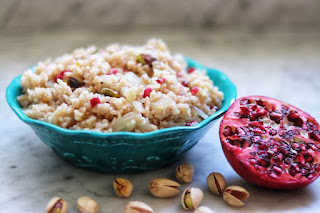For desserts, common ingredients were fruits, ginger, honey, spices and wine to sweeten things, but sweet and savory were often mixed. The Forme of Cury has a recipe for pork tartletts that includes currants. Fabulous Feasts, a collection of updated recipes from old manuscripts by Madeleine Palmer Cosman, offers a recipe for quince sauce with almonds, cloves, ginger, sugar, and wine starts with beef broth. A plum and currant tart from the same book starts with the marrow of four large beef bones! Here is one of the more intriguing combinations:
Perys Cofyns ("Pear Coffins")
This has three distinct steps: making the pears into "coffins" or "coffers" to hold the filling, cooking lentils (!) to supplement the berry filling, steaming the berries.
Step 1 — Start with 10 fresh hard pears, the juice of a lemon, and 3/4 teaspoon cinnamon. Cut the pears lengthwise, scoop out the core leaving about 1/2 inch pear wall. Sprinkle with cinnamon. Bake at 3508° for 5-10 minutes; do not let them get too soft. Set aside to cool.
Step 2 — Prepare the lentils. Rinse the dried lentils and place in a pot of water with a stalk of finely chopped celery, 1/2 teaspoon salt, 1/4 cup finely chopped dates, 1/2 teaspoon dried basil. Cover with beef broth. Bring to boil and cook 15-20 minutes until lentils are just tender but doubled in size.
Step 3 — Steam the berries. Rinse 1 cup raw cranberries, remove stems.* In pot with water, bring berries and 2 tablespoons sugar or honey to boil. When 1/3 of berries have popped open, remove from heat.** Cool the berries.
Put 1 tablespoon of lentil mixture into pears and top with the cranberries.
An interesting use of lentils to supplement the berry filling, but of course the lentils also include dates for additional sweetness.
As mentioned above, there were several ways to introduce sweetness into food, honey being very popular. Was sugar difficult to come by? Let's talk about then history of sugar in Medieval England tomorrow.
*The original recipe calls for "bog berries"; not being sure what was meant, Cosman substitutes New World cranberries.
**The medieval manuscript warns that the berries popping can spurt boiling water upwards, so do not lean over the pot too closely.





















